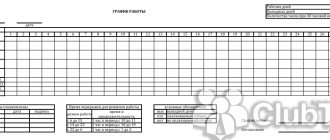In the realities of modern life, there are often situations in which a person performs work duties in two or more places, if time permits. If all these jobs are official (with the conclusion of an employment contract), then we are talking about part-time work. If several types of positions are combined for one employer, the combination is internal, and for different types of positions it is external.
In this case, the main job is considered to be the one where the employee spends the greatest amount of time, and the main sign of the main place of work is the storage of a work book in its personnel department.
An employee naturally spends significantly less time at a part-time job than at his main job. But this does not mean that for this reason he will have to rest for less time. Let's consider how the Labor Code of the Russian Federation regulates the duration of leave when combining positions, what rules exist in this regard, what financial resources are available to part-time workers when receiving leave and compensation and when not receiving it.
Legislative position of the Labor Code of the Russian Federation regarding part-time work and types of recreation
The Labor Code of the Russian Federation allows employees to perform other duties during the time not occupied by their main work, if they do not contradict their qualifications. This possibility is regulated in Chapter 44 of the Labor Code of the Russian Federation. In particular, the text of the Labor Code of the Russian Federation contains a mandatory requirement for employers to consolidate relations with a part-time worker in an employment contract, which will also include a clause regarding timely departure for the next vacation.
Payment for part-time work is carried out in accordance with the regulations of Art. 285 of the Labor Code of the Russian Federation, the eligibility of going on “part-time” leave is noted in Art. 286, and the issues of vacation payments are regulated by Chapter 19 of the Labor Code of the Russian Federation, which considers the issues of vacations for any form of employment.
Legislative regulation
The issue of the possibility for a working person to take a break from hard work is covered by Chapter 19 of the Labor Code of the Russian Federation, as well as by the norms of Federal legislation. In particular, Federal Law No. 181-FZ.
A person who officially has two or more jobs is considered an external or internal part-time worker. In the first case, these are two different companies and two different employment contracts, in the second there are also two contracts, two positions, but the employer is the same (Article 60.1 of the Labor Code of the Russian Federation).
It does not matter how much time a person devotes to a combined position, he, as in his main job, is required to be provided with legal vacations in accordance with the schedule.
Persons working part-time are granted annual paid leave at the same time . Even if a person did not get a second position for a long time, even up to two months (Article 291 of the Labor Code).
Watch a video about part-time work:
Vacation rules regarding part-time workers
Let's analyze the provisions of the Labor Code, according to which vacations are combined along with work. Several theses can be highlighted that reflect the general rules of vacation procedures for part-time workers:
- Every worker's annual vacation from work, financed by the employer, must be simultaneous for all places where the employee is employed. You cannot rest at one place of work while working at another.
- An employer who allows a part-time worker to work is not entitled to refuse leave at the required time, coinciding with the employee’s “main” leave.
- A part-time position does not require a mandatory 6-month period of service to qualify for annual leave. When receiving leave at the main place of employment, even if the employee has less experience at the second job, the employee has the right to rest in advance.
- An internal part-time worker going on annual leave receives it for two positions at once.
Payment and its features
Is vacation paid for part-time workers? The rules for calculating vacation pay for such people are standard (Article 139 of the Labor Code, Government Decree No. 922). When calculating, a standard formula is used and is based on average monthly income.
The leave of an internal part-time worker is paid according to special rules : accrual occurs under two different employment contracts (one contract for each position), and the payment is received by one person - the part-time worker.
Sometimes it happens that a person quits his first organization and part-time work becomes his main job. In this case, the formal procedure will not take much time; you can even not rewrite the employment contract, but draw up an additional agreement to it (Article 282 of the Labor Code).
This will also not affect the vacation period in any way, since it will include both the period of part-time work and the period of activity in the new place as the main one.
As for payment, things are no longer so simple. People usually earn less from a side job. Accordingly, it is this level of salary that will be taken into account in the calculations and vacation pay is also usually reduced.
Vacation duration issues
The law sets the minimum period of annual rest at 28 days. Paid leave no shorter than this period should be provided to part-time workers, despite the fact that they are employed for significantly less time than in the main position. Since the vacation time of a part-time worker at all workplaces must coincide, there may be various options for combining their duration. How exactly to resolve possible contradictions?
- At the employee's main workplace, extended leave is provided. What about standard part-time leave? Leave of more than 28 days is granted to certain categories of employees, for example, teachers have the right to rest for 42 days. If at the second job such an employee can only be given 28 paid days for a well-deserved rest, then the remaining two weeks must be provided to him at his own expense.
- Some employees have the right to additional leave, which they are given in addition to the main one (for example, those working in hazardous conditions, having small children, disabled people, etc.). Since this right does not disappear at another job, such an employee must receive additional leave there at the same time and of the same duration as at the main one.
- It may happen that the vacation at the main place of work turned out to be shorter than the vacation at a part-time job. You will still have to go to work at the same time. The employer compensates the part-time worker financially for unused days.
NOTE! The employer is not authorized to require documents from a part-time employee confirming the dates of vacation in the main position, but this is usually practiced. Such a document can be a certificate from the main employer, a copy of the vacation order, or an extract from the vacation schedule.
Nuances
As with all office work, the field of vacation registration is not without contradictions and nuances. For example, to resolve the difference in the duration of vacations at different companies, there are several options:
- the remaining number of days is provided without pay in agreement with the manager (the most common case);
- do not balance the difference in any way, but simply return, for example, from a resort earlier and begin performing duties at a second job , while continuing to legally rest at the first (inconvenient when combining positions in one organization, because when they see that a person has returned, he may be asked to work at main responsibilities);
- ask the boss to provide part of the days towards the next year ;
- ask to add time off earned during the year and not used (for example, for going out on holidays, for donating) to the vacation.
You can always find a compromise; it is important to know how leave is provided to part-time workers.
How do part-timers get paid for vacation?
The same as for key workers - these issues are regulated by the same article of the Labor Code of the Russian Federation. Vacation amounts are calculated based on average daily earnings. For obvious reasons, for part-time workers the amount will be less than for main workers, since they work fewer hours per day, and wages still depend on output.
Unused vacation days are subject to monetary compensation in the same way as for main employees. If there is an overexpenditure of the allotted days taken in advance for rest, then upon dismissal the amount for them will have to be withheld.
NOTE! The terms of vacation payments at different jobs do not differ - the employee must receive the funds due to him three days before the start of the vacation.
Other types of leave for part-time workers
In addition to annual leave, which provides paid leave and sometimes additional leave, the law gives workers the opportunity to take some other types of leave. He does not refuse this to his part-time partner either. But depending on the types of vacations, there are important features to consider.
Maternity leave, of course, cannot be transferred, so it is issued at all workplaces at once. A sick leave certificate confirming pregnancy at 30 weeks is provided to each employer, for which you need to ask the doctor to write it out in several copies. The expectant mother will receive the payments required by law at the birth of a child from only one employer, and she has the right to choose him herself.
For calculating maternity benefits, at least two years of experience in a particular workplace is crucial.
If it is 2 years or more both at the main job and at another (others), then the part-time mother will receive sick pay for pregnancy and childbirth at all her official places of employment.
Study leave is required by law to be provided exclusively by the main employer; this type of leave is often paid. A student working part-time must balance his strengths, combining not only several jobs, but also studies. If there is enough energy and time for this, then part-time work will not be a hindrance. Part-time students who have received legal study leave from their main job will have to solve the problem of additional employment in one of the following ways:
- take a few days from another job at your own expense for the time necessary to complete a session or prepare and defend a diploma;
- attend an educational institution outside of working hours;
- agree on a special schedule for the period of study, if the employer does not mind and the nature of the work allows it.
When is a part-time employee required to be given leave and how many days?
The relationship between a part-time worker and his employer is governed by the provisions of Chapter. 44 Labor Code of the Russian Federation. Such employees are also entitled to vacations, the design of which has a number of features. Let's consider what types of leave part-time workers can count on and what rules should be followed when granting them.
The main paid leave granted to part-time workers annually cannot last less than 28 days. At the same time, the employer, based on the norms of Art. 286 of the Labor Code of the Russian Federation must provide this leave simultaneously with the leave that the part-time worker receives at his main place of work.
A situation may arise when an employee at his main place is entitled to additional leave, as a result of which the duration of the entire vacation will exceed the duration of rest for his part-time job. The way out of this difficult situation is simple: the part-time worker is given leave without pay until the end of the “main” leave. If the part-time worker has not had 6 months from the start of work to the vacation, then he will receive it in advance.
IMPORTANT! As for educational and additional leaves for employees working in the Far North, they can be provided exclusively at their main place of work. The norm regulating this area is contained in Art. 287 Labor Code of the Russian Federation.
Partners have the full right to leave related to childbirth (maternity, child care).
For information on paying for maternity leave, see the material “Maternity benefits for part-time workers.”
The rules for calculating vacation pay for a part-time worker are identical to the rules for calculating payments at the main place of work. The basis for calculation is the actual salary of the part-time worker, taking into account the time during which he worked. First, the average daily earnings for the previous 12 months are determined, and then the resulting figure is multiplied by the number of vacation days.
You can read about the rules for calculating average daily earnings, as well as what payments should be taken into account when calculating, in the article “How to calculate the average monthly salary (formula)?”
Article 115 of the Labor Code of the Russian Federation establishes the number of required days of rest per year of work. According to the first part of the normative act, it is equal to 28 days. The second part of Article 115 talks about the possibility of increasing the number of days of rest for certain categories of citizens. Leave for part-time workers (number of days) is calculated in the same way as at the main place of work.
We suggest you familiarize yourself with: How long after vacation can you take, how is the priority established?
Let’s assume that an employee has been working at a company as an accountant since February 1. From the same date, he was hired part-time as a personnel officer. Going on vacation for 28 days, he writes two statements. Accordingly, two vacation orders are issued to an internal part-time employee for both positions. For 28 days he will not perform the duties of an accountant and HR officer at the same time, as he will be on vacation. If an employee is entitled to additional vacation days due to his part-time position, he will also receive them.
Important! The duration of the vacation is not affected by the number of part-time working hours.
Features of vacation registration for a part-time worker
As you know, planning vacation periods at an enterprise involves drawing up schedules. In the case of part-time workers, when you have to focus on the corresponding main work schedule, this may cause some difficulties:
- if a part-time worker knows the “main” vacation schedule, he reports it at another job, and the management enters these dates into the compiled schedule;
- if the date of leave from the main job has not yet been determined, and the part-time schedule is already being drawn up, then the line where the date is indicated is left blank, and in the “Note” column the entry “Part-time” is made;
- for internal combinations, two vacation documents are drawn up, separately for each position; although they will be identical, the differences will only be in the “Position” and “Personnel Number” columns.
Decor
The procedure for sending a person on leave in both positions looks standard:
- the employee writes a statement of this type;

- the director issues an order to grant vacation, the accounting department receives an order to accrue vacation pay and prepare papers;

- on the appointed date, the subordinate goes on legal vacation.
At the stage of forming a schedule, the HR service may not know when a person working part-time in their company is scheduled to take a planned vacation at their main place. In this case, the time limit for vacations is not reflected in the schedule .
The fact of part-time employment is recorded in column 10 , dedicated to notes. If in second place they know exactly when to let a person go on vacation, then the dates are put on the schedule according to the usual rule.
When releasing an internal part-time worker on vacation, the director notes in the order that this is a vacation for both the main position and the additional one , even if it is one period. For this purpose, form No. T-6a is used (Decree of the State Statistics Committee No. 1 of January 5, 2004), applied to the registration of several vacationers at once.
The same person is indicated ; filling in the fields of personnel number, position and sometimes structural unit will differ.








